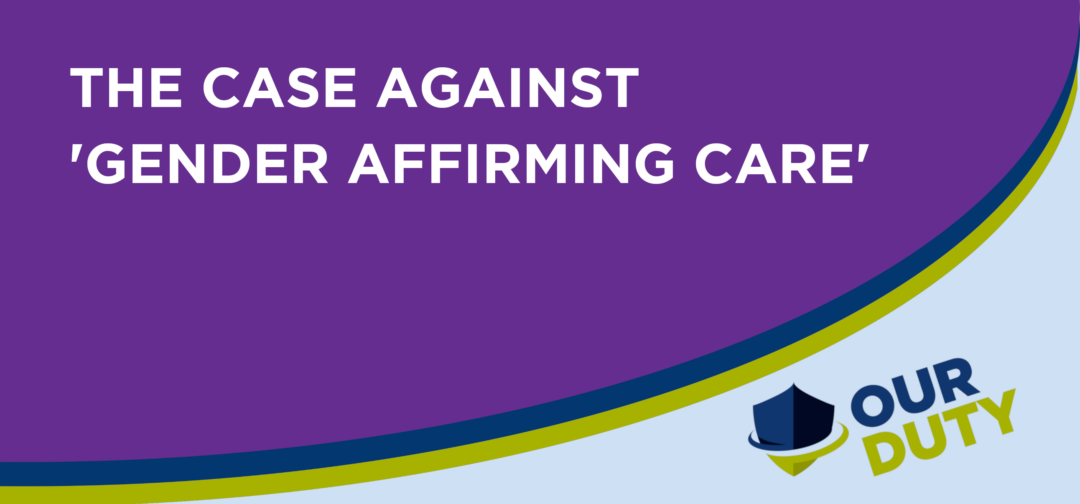We are frequently told that ‘gender affirming care’ is lifesaving (when we know that it is not), we are told that all the major medical bodies approve of it (and we cannot understand why). The whole realm of ‘gender affirming care’ is riven with language that seems designed to obfuscate and bamboozle (including the very description ‘gender affirming care’).
The medical and psychosocial interventions that constitute ‘gender affirming care’ start with ‘social affirmation’ which is the acceptance that somebody identifies as somebody different from their reality. They might claim to be the opposite sex, or non-binary, such claims start a person on a pathway which, if they do not escape from it, leads inexorable to medicalisation.
Ideally, we should have new, neutral and objective, terms for those interventions that constitute ‘gender affirming care’. For a start, we can be unequivocal that it is not ‘care’ in any true sense of the word. For now, we shall call it just ‘gender affirmation’, although we must be clear that in reality it is humouring a delusion.
What follows is the top ten arguments for curtailing so-called ‘gender affirming care’.
- Risk of Medicalization: Gender affirmation often involves medical interventions such as hormone therapy and surgery. These interventions can carry significant risks, especially when performed on minors whose bodies are still developing. Research has shown potential long-term health consequences, including infertility, cardiovascular issues, and bone density problems associated with hormone therapy and surgeries.
- Ethical Concerns: Administering irreversible medical treatments to minors raises ethical questions about autonomy, informed consent, and the ability of individuals to fully understand the implications of such procedures. Children and adolescents may not have the capacity to make decisions about permanent alterations to their bodies, particularly when influenced by societal pressures or temporary feelings of dysphoria.
- Lack of Long-Term Data: Longitudinal studies on the outcomes of gender affirming treatments, especially in minors, are limited. The field lacks robust, long-term data on the physical, psychological, and social effects of hormone therapy and surgeries, making it challenging to fully assess the risks and benefits of these interventions. Those organisations which legitimise ‘gender affirming care’ do so without a logical, objective, or evidenced, basis.
- Potential for Regret: Research on detransitioners, individuals who had their gender delusion medicalised but who later accepted the reality of their sex, highlights the possibility of regretting irreversible medical interventions. The phenomenon of detransitioning underscores the need for more stringent gatekeeping on the medicalisation of gender, particularly in young people.
- Impact on Mental Health: While gender affirmation is often promoted as a solution to alleviate gender dysphoria and improve mental well-being, evidence suggests that psychological outcomes vary widely among individuals. Some studies indicate that a significant portion of individuals who identify as transgender continue to experience mental health challenges even after transitioning, underscoring the need for comprehensive mental health support instead of medical interventions.
- Alternative Therapeutic Approaches: Gender affirmation overlooks alternative therapeutic approaches that focus on addressing underlying psychological factors contributing to the feelings labelled gender dysphoria. Psychotherapy, family counselling, and social support networks are advocated as less invasive options that prioritize mental health and well-being without resorting to medical interventions.
- Influence of Social Contagion: Concerns have been raised about the role of social contagion, particularly among adolescents, in the rise of gender dysphoria diagnoses and requests for gender affirmation. Peer influence, social media, and cultural trends contribute to the identification with transgender identities, leading to an increase in demand for medical interventions without thorough exploration of underlying factors.
- Gatekeeping and Affirmation: The currently normalised approach to gender affirmation has been criticised for its lack of rigorous assessment and gatekeeping procedures. The emphasis on affirmation and immediate access to medical interventions bypasses necessary evaluations of mental health, underlying trauma, and potential comorbidities. Diagnostic overshadowing is the term given to attributing to gender that which can be better explained by exploring the likely causes of transgender ideation.
- Parental Rights and Consent: Questions arise regarding parental rights and consent in the context of gender affirmation for minors. Debates centre on whether parents have the authority to consent to irreversible medical treatments on behalf of their children, especially when there is disagreement between parents or concerns about the child’s capacity to understand the implications of such interventions. These questions remain valid once the child is over the age of majority when they exhibit symptoms of poor mental health or compromised capacity for critical thinking.
- Cultural and Societal Implications: Gender affirmation intersects with broader cultural and societal debates about gender, identity, and the medicalisation of social issues. The normalisation and widespread promotion of gender transitioning serves to reinforce gender stereotypes, undermine the recognition of biological sex differences, and contribute to social polarisation on the issues arising from transgender ideation.

